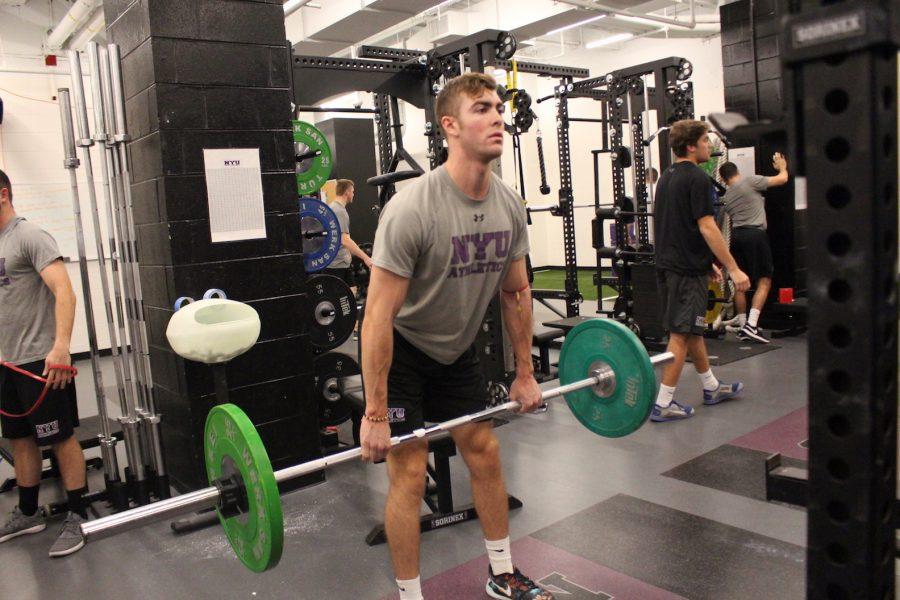The Importance of Athletic Trainers in College Sports
NYU’s athletic training room is located at the Palladium Athletic Facility on 14th street. The training room provides treatment before and after competitions for athletes and rehab programs, among others.
February 21, 2017
NYU’s athletic training room is tucked away beneath Palladium Athletic Facility on 14th Street, and the university competes at the NCAA Division III level in all of its sports, with the exception of fencing. Athletes go to the training room to receive treatment before and after competitions. There, athletic trainers guide injured athletes through rehabilitation programs when injured and assist with icing, heating and electrical nerve stimulation to keep their bodies performing at their highest levels.
Coordinator of Athletic Training Nikki Webb oversees all training room medical activities and the strength and conditioning program. Webb has been part of the NYU community for 10 years, joining the Violets after working with Columbia University and University of South Florida. She originally had medical school plans, but those were altered when she spent time as a student trainer when she was an undergraduate.
“Initially, I was on the med-school track, but working at the collegiate level as a student-athletic trainer and an athletic training student,” Webb said. “I really liked that setting. I knew that college athletics was where I felt at home.”
NYU’s well-balanced student-athletes make trainers like Webb want to work with them.
“I very much enjoy this particular student-athlete population,” Webb said. “Our student-athletes are focused academically and manage their time very well. I see how hard they work, I know what their goals are and our whole staff is here to help them achieve their goals.”
The work of the athletic training department is done collaboratively with the intent of achieving the best results for the students in their care.
“Our current training methods and staff are very hands on instead of just prescribing exercises and going from there,” Webb said. “Whether it be through massage or graston, we try to use as many resources as possible. If one of our staff members has a lot of experience in one area, other staff members can learn from him or her.”
After 10 years on the job, Webb delights in seeing the transition of injured athletes back into the competitive environment.
“It’s very fun to see our athletes go from injured to back on the playing field in a healthy and safe manner and it’s rewarding to see someone go through that process,” Webb said
CAS junior Erika Tretner is in her third year as a student assistant in the athletic training room. After leaving behind high school athletics, Tretner has thoroughly enjoyed her role within the training room. Tretner has a number of responsibilities, including preparing supplies for team practices, conducting concussion tests and helping athletic trainers with rehabilitation. One of Tretner’s favorite aspects of her job is assisting athletic trainers with medical coverage at athletic events.
“I’m interested in emergency medicine, so assessing and taking care of an injury right off the field or court has been quite fun,” Tretner said.
When an athlete is facing a recurring physical problem or has been plagued with a season-ending injury, Tretner said she does her best to make rehabilitation as fun as it can be.
“It’s important that the athletes feel comfortable with the staff and room,” Tretner said. “We want them to want to come back, this way we can get them back to play as soon as possible.”
The training environment has impacted Tretner positively in both the professional and personal realms.
“The athletic trainers are all wonderful and resourceful,” Tretner said. “I have been able to learn so much, gain experience in the healthcare field, and make some amazing friends”
CAS junior and women’s soccer forward Marquel Love transferred to NYU after playing two seasons at Humboldt State in Arcata, Calif. Love has torn multiple ligaments that keep her patellas in place in both knees. The training room has been a welcoming environment for Love, allowing her to be proactive regarding her injuries without feeling weak.
“I ultimately thought that it was going to end up costing me my soccer career considering the fact that cutting, turning, and dynamic movements caused my patella to slide out of place,” Love said. “The athletic trainers have done a great job working with me and finding ways to strengthen my muscles around my patella as well as finding knee braces for me that I can use while I play to assure that they stay in place.”
NYU athletic trainers have helped Love not only physically, but also mentally — she expressed how she couldn’t begin to imagine where she would be without the help and motivation the NYU athletic trainers provide on a daily basis.
Considering that March is National Athletic Training Month, it’s time we gave athletic trainers the recognition they deserve. Athletic trainers positively impact the physical and mental health of an athlete, helping the team win and succeed.
A version of this article appeared in the Monday, Feb. 21 print edition. Email Trevor Francesconi at [email protected].



























































































































































